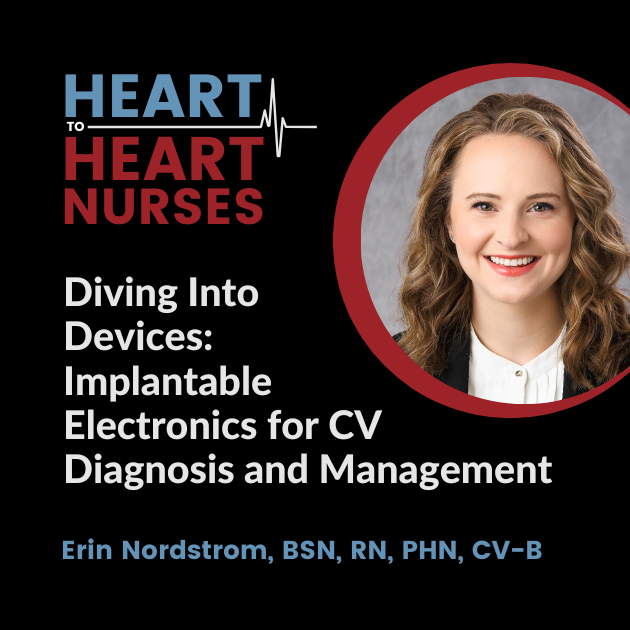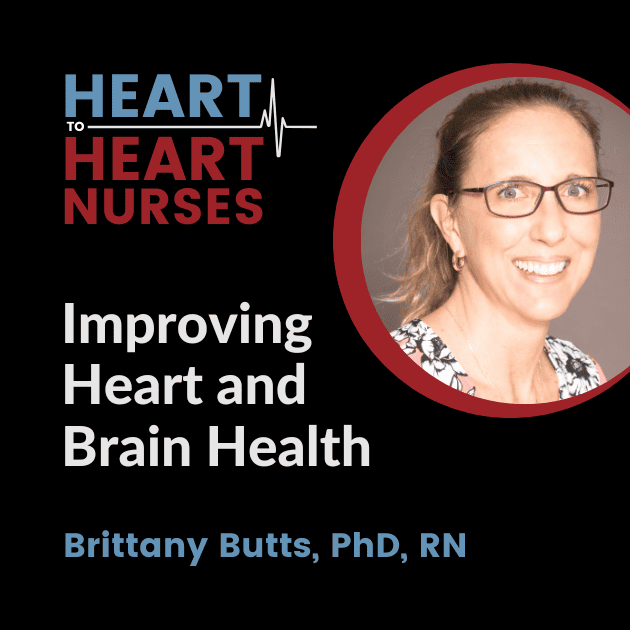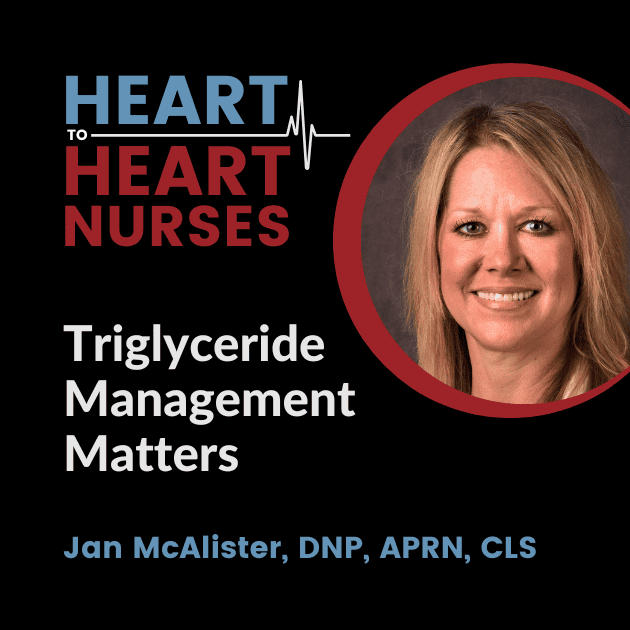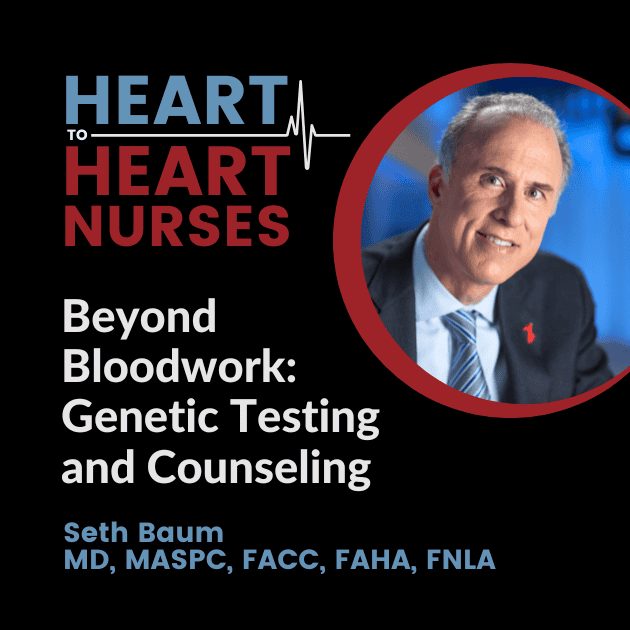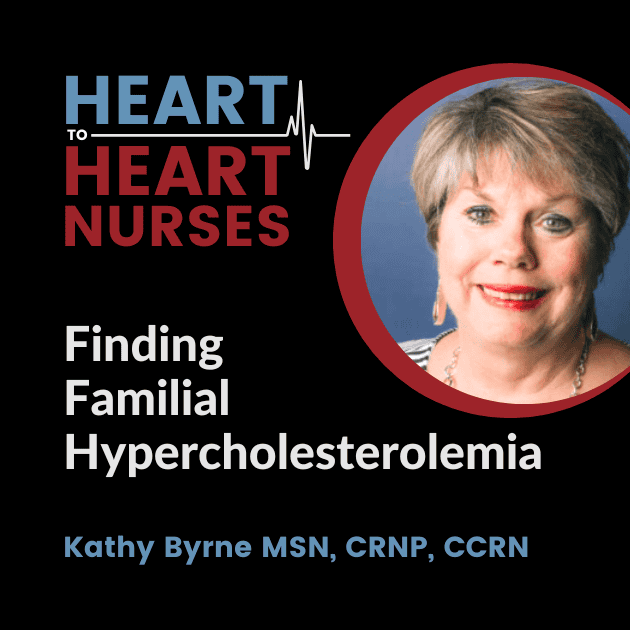Kathryn Wood, PhD, RN, FAHA, FAAN, discusses paroxysmal supraventricular tachycardia (PSVT) and other similar episodic rapid heart rate conditions. Dr. Wood describes pathophysiology, prevalence, symptoms, and disparities related to diagnosis and treatments and shares helpful resources for providers and patients.
This podcast episode was supported by grant funding from Milestone Pharmaceuticals.
Episode Resources
- Kathy Wood's 2015 paper with PSVT images and details: Wood K. Mechanisms and clinical manifestations of supraventricular tachycardias. Prog Cardiovasc Nurs. 1995;10(2):3-14.
- Symptom research:
- Wood KA, Drew BJ, Scheinman MM. Frequency of disabling symptoms in supraventricular tachycardia. Am J Cardiol. 1997;79(2):145-149.
- McCabe PJ, Chamberlain AM, Rhudy L, DeVon HA. Symptom Representation and Treatment-Seeking Prior to Diagnosis of Atrial Fibrillation. West J Nurs Res. 2016;38(2):200-215.
- McCabe PJ, Rhudy LM, Chamberlain AM, DeVon HA. Fatigue, dyspnea, and intermittent symptoms are associated with treatment-seeking delay for symptoms of atrial fibrillation before diagnosis. Eur J Cardiovasc Nurs. 2016;15(6):459-468.
- McCabe PJ, Rhudy LM, DeVon HA. Patients' experiences from symptom onset to initial treatment for atrial fibrillation. J Clin Nurs. 2015;24(5-6):786-796.
- Streur M, Ratcliffe SJ, Callans D, Shoemaker MB, Riegel B. Atrial fibrillation symptom clusters and associated clinical characteristics and outcomes: A cross-sectional secondary data analysis. Eur J Cardiovasc Nurs. 2018;17(8):707-716
- Disparities: Gleason KT, Nazarian S, Dennison Himmelfarb CR. Atrial Fibrillation Symptoms and Sex, Race, and Psychological Distress: A Literature Review. J Cardiovasc Nurs. 2018;33(2):137-143.
- Patient preferences in AFib education: Lane DA, Aguinaga L, Blomström-Lundqvist C, et al. Cardiac tachyarrhythmias and patient values and preferences for their management (EHRA, HRS, APHRS, SOLEACE consensus document). Europace. 2015;17(12):1747-1769. DOI: 10.1093/europace/euv233
- 2020 ESC Guidelines for the diagnosis and management of atrial fibrillation: Eur Heart J. 2021 Feb 1;42(5):373-498. doi: 10.1093/eurheartj/ehaa612.
- AHA My AFib Experience
- StopAFib.org
Welcome to Heart to Heart Nurses, brought to you by the Preventive Cardiovascular Nurses Association. PCNA's mission is to promote nurses as leaders in cardiovascular disease prevention and management.
Geralyn Warfield (host): Welcome to the first of a three-episode miniseries focused on paroxysmal supraventricular tachycardia, or PSVT. We encourage our listeners to listen to our other two episodes, which focus on the patient journey and on treatments.
But to start us off today, we're going to be discussing more about PSVT pathophysiology and how it is similar and different from other episodic heart rate conditions. I'm pleased to welcome today's guest, Kathy Wood. Kathy, could you introduce yourself to our audience?
Kathy Wood (guest): Thanks, Geralyn. I'm Kathy Wood, Associate Professor at Emory University School of Nursing.
I've worked specifically with arrhythmia patients since 1986, and my research now is [00:01:00] focused on the underpinnings of symptoms experienced by these arrhythmia patients.
Geralyn Warfield (host): Well, I'm sure our audience can tell that we have an expert at the table with us today. So, let's go ahead and dive in. Kathy, could you please tell us what the term paroxysmal supraventricular tachycardia means, and how common these arrhythmias are?
Kathy Wood (guest): It's kind of a mouthful, isn't it? SVT is how we abbreviate it. And that's an umbrella term for any fast heart rhythm above the ventricles—so, in the atria mainly—and a heart rate greater than 100 beats per minute.
This means that the fast rhythm is initiated, and occurs, directly in the atria. Traditionally that means all tachycardias apart from AFib and ventricular tachycardias.
They're typically regular, narrow QRS rhythms, although there is an exception to this in one type of SVT that can present as a wide QRS tachycardia, but we can talk about that later. [00:02:00]
All SVTs are started by a premature atrial beat. Sometimes a ventricular, an early ventricular beat can initiate reentry, but it's most often atrial.
And that's also necessary for these reentrant SVTs to occur is a unidirectional block in an area of slowed conduction, just enough to find part of that circuit repolarized and ready to accept that premature beat. Then the SVT starts and it's off to the races around the reentrant circuit.
SVTs are relatively common, but rarely life threatening. Accurate epidemiology data on SVT incidence and prevalence is sparse, mainly because of underreporting. But an old 1998 data report estimated that there's about 80,000 new cases a year, and 570,000 patients with SVT in the U.S.
The main hallmark is they start sporadically, [00:03:00] and they're random in their occurrence.
Another hallmark is a sudden start and sudden stop of the tachycardia. Initially, the episodes are very, very short. They're rare, and can be from seconds to minutes. But the natural course of the condition is changes over time, so that with more time, the episodes begin to occur more frequently and with longer durations.
The vast majority of these patients will have no underlying heart disease. So, they're essentially healthy people with an electrical wiring problem.
Geralyn Warfield (host): So, you hinted in that last description of the different types of SVT. Could you go a little bit deeper into those differences?
Kathy Wood (guest): Sure. There's three main types of SVT that come to mind when people talk about SVT. They're all due to reentrant circuits. They're just in different anatomical areas of the heart.
About 50 to 60% of SVT is AV nodal tachycardia. That's atrioventricular [00:04:00] nodal tachycardia. And the tachycardia occurs within the AV node. And we call that garden variety because it's so common.
20 to 30% is what's called AV reciprocating tachycardia, such as patients with Wolff-Parkinson-White, or WPW, syndrome. And this is using an accessory pathway outside of the AV node as part of the reentrant circuit.
And then the very last type, is about 10%, and that's ATach [atrial tachycardia].
There's also less than 1% of junctional tachycardias, but the main three are what you commonly run into in practice.
The most common type is AVNRT, as I mentioned. And so, there's a slow pathway and a fast pathway within the AV node. So the impulse goes down the slow pathway and then back up in the fast pathway to set up the reentrant loop within the AV node. [00:05:00]
The atria and ventricles are being told to pump at the same time against one another. So, remember that when we talk more about symptoms.
This type is more common in women, and the typical AVNRT patient is a middle-aged woman. We know that estrogen affects conduction through the AV node, so at different times in women's lives where estrogen levels are changing, such as during pregnancy or in menopause, is often when the patients notice more or less episodes of AVNRT.
The second type, AVRT, is due to a reentrant loop, as I've said, across an accessory pathway. This pathway conducts the atria and ventricles electrically, and is outside of the normal circuit that goes through the AV node. It's more commonly seen in men than in women. and very commonly first picked up when adolescent teenage boys work out hard, or they try out for high school or college sports.
Remember one of the normal purposes of the AV note [00:06:00] is to delay conduction so the blood has time to be pumped from the atria to fill the ventricles before the ventricles contract and pump blood throughout the body. So, without the conduction pausing as the impulse goes through the AV node, ventricular filling time is shortened, so there's less blood going forward to the brain and body. And this is when patients get dizzy and lightheaded.
Without getting into the weeds too much here, there's one type of AVRT that goes down the normal pathway and back up retrograde through the accessory pathway. And there's another type that goes down the pathway and retrograde through the normal conduction, and that second is called antegrade, and the first is called orthodromic conduction.
Then lastly, the third and smallest group of SVTs is atrial tach, and ATach is usually initiated by irritable atrial cells that start in the [00:07:00] left or right atrium. A key feature of ATach is, instead of a sudden start like most SVTs, these have a gradual ramping up of the heart rate from a normal sinus rhythm to tachycardia.
And ATach can be very difficult to treat. It's seen, when it is seen, it's seen often in children or adults who have had congenital heart surgery. So, the reentrant circuit is around the scar from the prior congenital heart surgery.
In this also, you can see atrial tach, a multifocal type of atrial tach, in patients in critical care units. And these patients are usually very critically ill and the best treatment is to solve the underlying problems such as sepsis or infection.
For those listeners who are visual learners, I added an old 1995 paper of mine to the reference list from Progress in Cardiovascular Nursing. And that has more details and pictures of what occurs during these different types [00:08:00] of SVTs that may help better understand what's going on.
One other point I guess I should make is that, technically, AFib and AFlutter fall under the umbrella term of SVT because they technically are tachycardias in the atria above the ventricles. But because AFib is so incredibly common, much more so than any other arrhythmia we see, and it behaves so differently than other SVTs (in fact we still don't know what causes AFib), we consider AFib in a class by itself.
And that's the same for AFlutter, although not quite as common as AFib, Flutter is the second most common arrhythmia we see, and much more prevalent than other SVTs. The reentrance circuit in Flutter is on the floor of the right atrium. So AFlutter behaves and responds more like SVTs, but they also, these patients need to be anticoagulated like AFib, so AFlutter has a few properties of both.
Geralyn Warfield (host): So, thinking [00:09:00] about both of those, about SVTs and about AFib, how would those symptoms be different?
Kathy Wood (guest): Yeah, that's a good question. A lot of the symptoms are the same, but there are differences.
Mainly the symptoms depend on the type of SVT and other factors such as how high the heart rate goes during the SVT, the patient's age, and if they have other associated comorbidities, or conditions, chronic conditions.
Patients may be asymptomatic or mildly symptomatic, but most SVT patients are aware of, and will distinctly describe, their symptoms.
Typical symptoms are palpitation, dyspnea or shortness of breath, lightheadedness or presyncope, polyuria, diaphoresis, nausea, and chest discomfort or tightness. Polyuria is listed in the textbooks as occurring 5-10% of the time, but we did a study in the late [00:10:00] 1990s and found that it actually occurred almost 30% of patients experienced having to go urinate more frequently in bigger volumes. This is related to more blood flow with the higher heart rates going to the kidneys.
Patients often describe their symptoms of SVT and AFib as feeling like they have a fish flipping around in their chest. But once SVT begins to happen more often, patients report increasing symptoms of anxiety and fear because they never know when it's going to occur and it's an issue of loss of control.
One distinguishing feature of AVNRT is what we used to, years ago, call a frog positive sign, but it's pulsations in the neck that patients will remark they feel when they're lying down more than when they're standing or sitting, but it's because the atria and the ventricle are competing and pumping at the same time, so blood flow goes backwards from the atria [00:11:00] into the veins, pulmonary veins.
The symptoms differ in AFib and AFlutter from other SVTs as well, because AFib and AFlutter patients are usually older than other SVT patients, and can have underlying heart disease.
AFib patients can be asymptomatic or symptomatic. But if they're symptomatic, they describe more symptoms of fatigue and dyspnea on exertion. And some palpitations, but they're more aware of the fatigue and the shortness of breath because when you're in AFib, you lose 25-30% of your cardiac output. These patients have similar symptoms to heart failure patients, if that makes sense.
AFlutter patients usually have similar symptoms to SVT because their atrial rates are so fast, usually at least 2 to 3 to 4 to 1 ratio of atrial to ventricular rates. So, they have symptoms of palpitations and lightheadedness. [00:12:00]
There are a few nursing research studies that I added to the reference list on how symptom patterns and symptom clusters differ in AFib, so that may be of interest to our listeners who are focused more on symptom research.
Geralyn Warfield (host): We have been talking with Kathy Wood about PSVT prevalence and how it compares to other episodic heart rate conditions. We will take a quick break and be right back.
Geralyn Warfield (host): Welcome back to our audience, as we continue our discussion about PSVT. Kathy, you mentioned earlier that one type of SVT is more prevalent in women. Is there any evidence that there are disparities in symptoms, or disparities in diagnosis, or even access to treatment based on gender?
Kathy Wood (guest): Yes, that's a good question, Geralyn. There are reports from the literature of women's struggle to obtain correct diagnosis as women with SVT are more often misdiagnosed with panic disorder or anxiety attacks than men with SVT.
Women are also more likely to receive treatment with anti-anxiety agents [00:13:00] than anti-arrhythmics; diagnosed later in the disease trajectory so that they're sicker when they're diagnosed; and referred less often for ablation treatment.
For women with AFib, delayed access to ablation treatment and oral anticoagulants are also disparities noted in the literature.
We found that women have more ER visits than men with SVT and AF, and therefore more health care expenses to the system. And because women are diagnosed later in their disease trajectory in AFib, they have other comorbidities. And that probably explains why there's more strokes in women with AFib. And when they have strokes, there's worse outcomes in women than in men.
And then as far as the difference in symptoms by gender and SVT, women tend to have more symptoms and lower quality of life before ablation treatment, but then they have bigger change scores or more improvement from treatment, so they end up [00:14:00] equal to men after the treatment.
And for AFib, this is a similar symptom pattern, but women also have been reported to experience more anxiety and depression than men, along with physiological symptoms.
Geralyn Warfield (host): Could you please describe for our audience the role of patient education when it comes to PSVT and AFib?
Kathy Wood (guest): I'm so glad you asked about that because patient education in SVT and AFib is so important. And often, they, they're short-sheeted on that when they are at clinic visits.
There have been recommendations by the professional societies such as American Heart that we move to an integrated care model for outpatient SVT and AF patient care that includes a nurse or nurse practitioner and physician instead of only a physician, as well as professionals such as pharmacists or nutritionists, to encourage more active patient involvement. The use of multidisciplinary teams have, have shown to result in more guideline- [00:15:00] directed care and a more comprehensive approach to patient teaching.
And often the use of more Smart technology or wearables. So, the integrated care approach has been embraced, but it's not yet in practice in many centers.
Key teaching points you need to remember when you're educating these arrhythmia patients are:
- the anatomy and physiology of SVT and/or AF, or Aflutter;
- the trajectory of episodes—that they'll become more frequent as time goes on, and the duration will increase;
- the treatment options in the use of oral anticoagulant with AF patients--andAFlutter patients are also anticoagulated—and that can be a whole discussion in its own.
So, they should always leave the office with an action plan should another episode occur.So, they. they know what to do if an episode happens at home.
I guess as a tease for the next podcast, I'll mention an excellent 2015 [00:16:00] European Society of Cardiology paper that'll be on the reference list about arrhythmia patient values and preferences. It's a wonderful resource of what types of content should be included when teaching AFib patients about their disease, but it also applies to SVT patients. That’s Table 2 in the paper.
And then there's also a key, a table, that covers topics that are important to cover when teaching AF and SVT patients about their disease, and points to include when you're discussing oral anticoagulant. That's the 3rd table in the paper.
And then for patients, there are great tables—one is Table 4 and one is Box 4—that has a well-vetted list of patient advocacy groups, foundations, and websites for accurate information, and a list of websites if they have questions about what to ask during their initial visits with their physician.
Geralyn Warfield (host): During the third episode in this mini- [00:17:00] series, we are going to talk a little bit more about treatment options, but I'm hoping, Kathy, that you could talk a little bit about the importance of lifestyle modification and risk factor reduction in AFib.
Kathy Wood (guest): That's a great point. In AFib, it's a pillar of management, but in SVT patients, it hasn't been pushed or advertised in the literature as much. And I think it's important for both types of arrhythmia patients, but for different reasons.
SVT patients often go through a very frustrating process of ruling in or ruling out causative factors that can precipitate their SVT episodes. So frustrating.
And they try to avoid certain foods or beverages, but the SVT happens anyway. So, in those patients, you should discourage them from lifestyle restrictions, such as avoiding coffee, red wine, chocolate, or avoiding exercise, because it really won't matter. SVT episodes are so random and they're going [00:18:00] to happen anyway. So, avoiding certain things and changing their diets are not very helpful.
But in AFib, it's a big difference. In recent evidence, in the literature has shown that an increased exercise of at least 150 minutes per week, losing 10 percent of their body weight if they're overweight, decreased alcohol intake, and CPAP treatment for sleep apnea, all decrease the episodes of AF.
So, it's important to counsel obese patients with AFib to lose weight, although it's a really hard thing to do. So, we've suggested in, in certain AHA presentations that you say to patients you're concerned that their weight is causing problems with their atrial fibrillation and then set small achievable targets like, “Start by losing 5 to 10 percent of body weight,” or even a referral to a nutritionist can be healthy.
But the literature shows that if it's brought [00:19:00] up by a health care professional that they should lose weight, patients were three times more likely to lose weight than if this conversation never happened. So, it's important to discuss this with patients when you see them.
Geralyn Warfield (host): Kathy, is there anything else that you would like to add?
Kathy Wood (guest): Thanks, Geralyn. Two excellent websites that providers can refer patients to are the AHA My Afib Experience website and StopAfib.org. Both of these have multiple education resources for patients, and an online AF support group that are monitored by professionals. Patients can ask questions, share their experiences, and have confidence that the information is accurate. So, I think those are helpful for both providers and patients.
Geralyn Warfield (host): We are so grateful to Kathy for being here today to talk a little bit more and encourage us to be very mindful of PSVT as well as AFib in our clinical practice. The resources that she's described [00:20:00] will be available in the show notes, so you can check out those links there.
And don't forget to listen to the other two episodes in this mini-series.
And for even more information and resources, please check out the episode show notes, where you will find some additional links that Kathy did not mention.
We'd like to thank Milestone Pharmaceuticals for their grant funding for this podcast episode.
This is your host, Geralyn Warfield, and we will see you next time.
Thank you for listening to Heart to Heart Nurses. We invite you to visit pcna.net for clinical resources, continuing education, and much more.
Subscribe Today
Don't miss an episode! Listen to the Heart to Heart Nurses podcast on your favorite podcast listening service.







